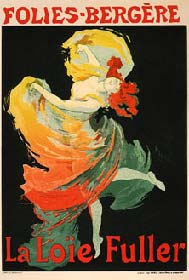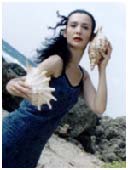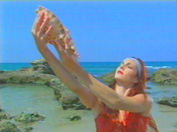| |
Dance
on Screen
By Lila Moore PhD

Loie fuller was the first artist to blend cinematic and choreographic
concepts into a new form of dance.
“I was more and more enthusiastic about her marvellous
ephemeral art. That wonderful creature – she became
fluid, she became light, she became every colour and flame,
and finally she resolved into miraculous spirals wafted toward
the Infinite.
She was one of the first original inspirations of light and
changing colour”.
Isadora Duncan
Dance
for the camera is a unique and evolving art form that manipulates
movement in space and time to produce choreography as a film
form and event. Maya Deren invented the concepts of “chorecinema”,
“film dance”, “film-ritual” and “trance
film” during the 1940s and integrated content and form
into radical chore-cinematic depictions. In Ritual in Transfigured
Time she combined dance forms, ritual forms, and films forms
to explore the metaphysical dynamics of a rite of passage.
Her fascination with tribal religious experience and extreme
states of mind including ritual, meditation, and trance, inspired
many filmmakers and choreographers.
Like
other women before me, discovering Maya Deren’s films
and writings has had a great impact on the course of my creativity
as an artist and filmmaker and on the academic research that
runs in parallel as a form of theoretical reflection. Moreover,
it affirmed my conviction that there is a language with which
the feminine realm of existence can be discovered and expressed
through the fusion of film forms and dance forms. Language
that is free from the old patriarchal conventions of Hollywood
and as close to the truth as poetry. Language that does not
rely on linear story-telling or even words, to express the
complexity and beauty of the human experience and soul.
The
extraordinary film At Land (1944) begins with Maya Deren
washed to the shore by the sea, emerging from the primeval
waters like ‘a mythological being from another world’.
With sea waves rolling backward the scene is filmed and
edited in such a way ‘as to transcend ’real
time’.
The woman seems to embody all time; it is as though she were
walking through history and into the future’.
(Cited from the article At Land by Margaret Warwick)
The silent black and white film contains inner music and vivid
depictions that no colour or sound could match. The poetic
substance, the performance and choreographic structure bring
forth the dance of the feminine Self and Soul.
Maya
Deren believed in the primal power of cinematic images to
convey in a poetic and metaphoric manner situations that words
or explicit illustrations often fail to deliver. With the
aid of cinema she gave the dancers, and herself, the world
as a stage. In her last film she even attempted to take her
voyage to the Universe by placing dancers like starry constellations
floating within The Very Eye of the Night.
In
my PhD thesis entitled Dance on Screen completed in Middlesex
University, UK I demonstrate choreography for the camera and
the screen or Screen Choreography as a unique art form. It
is a form that has its roots in the early movements of modern
art, performance art, mixed media and experimental film. In
parallel I show how this art form is often utilised for the
expression of distinctive content that escapes other art forms
or the limits of theatrical dance, plot driven and dialogue
based cinema. The thesis evolves through reflection on the
dance film Gaia – Mysterious Rhythms and the analysis
of a series of award-wining films based on the creative concepts
of Screen Choreography.
“I was born by the sea… My first idea of movement,
of the dance, certainly came from the rhythms of the waves.
I was born under the star of Aphrodite, Aphrodite who was
also born on the sea… Isadora Duncan.
 Gaia- Mysterious Rhythms Gaia- Mysterious Rhythms
Dance film by Lila Moore
Coming
out of the sea like a returning tide the woman follows the
rhythms of the moon, earth and the sun across the sky from
dawn to dusk in a dance-rite tinted by the shining hues of
Gaia.
In quest for the mysterious Key of Life she merges in
a poetic landscape of matter and spirit engulfed by soundscape
that echoes Earth’s beauty and antiquity.
(Extracts
from PhD thesis).
Visual Poetry
The
film Gaia – Mysterious Rhythms was originated and created
as a visual poem. According to Maya Deren, in the symposium
on the topic Poetry and the Film, held in Cinema 16, 1953,
“the distinction of poetry is its construction…
the poetic construct… is an investigation of a situation,
in that it probes the ramification of the moment, and is concerned
with its qualities and its depth, so that you have poetry
concerned, in a sense, not with what is occurring but what
it feels like or what it means. A poem, to my mind, creates
visible or auditory forms for something that is invisible,
which is the feeling, or the emotion, or the metaphysical
content’.
Maya Deren added another important factor to explain the
inner-logic of non-linear progression of images and scenes
in cinematic poetry: “The images in dreams, in montage, and in poetry…
are related because they are held together by either an emotion
or a meaning that they have in common, rather than by the
logical action. …It is the logic of a central emotion
or idea that attracts to itself even disparate images which
contain that central core, which they have in common.
Russian
film director Andrei Tarkovsky also explored the relationship
between the language of film and poetry. In fact, Tarkovsky,
who avoided making comparison between cinema and other art
forms, actually found poetry, and in particular ancient haikku
Japanese poetry, closer to the truth of cinema. Tarkovsky
identified the basic element of cinema as observation, for
him, ‘the cinema image is essentially an observation
of a phenomenon passing through time’. Tarkovsky quoted
the following haikku by Basho:
The old pond was still
A frog jumped in the water
And a splash was heard.
Tarkovsky
found the verses beautiful ‘because the moment, plucked
and fixed, is one. And falls into infinity…
And more precise the observation, the nearer it comes to being
unique, and so being an image”
What
attracts me to the poetic form and content, as exemplified
in Gaia – Mysterious Rhythms, is the potential of visual
poetry to convey ideas, meanings, impressions or feelings
within the context of film-making. It is the option to work
with images and sounds rather than with words, and the chance
to reveal or discover, even for a brief moment, the invisible
movement or emotion which resides at the heart of a visible
phenomenon.
A
Rite of Passage
Gaia
– Mysterious Rhythms originally evolved from a series
of images, which formed in my mind as separate scenes. The
scenes that can be described as visual events are linked by
the theme of a rite of passage and transformation.
The protagonist, a young woman, goes through a process of
transformation whilst she interacts with the living elements
of the natural environment. She exists in a universe where
the earth, sea, moon and sun are ‘key players’.
She reflects her environment and nature is reflected through
her.
The
rite begins at dawn, when the moon is still above the sea
and the tide is out, and is completed at dusk, when the sun
dissolves in the sea. Each scene is visually painted by the
lighting conditions throughout the day following the movement
of the sun across the sky.
Each
scene is a stage forward in a transformation process and composed
of a series of ritualistic movements. The major driving force
to the rite is born from the longings to overcome physical,
and in particular, man-made limitations, to bond with the
natural environment and discover one’s identity through
contact with the elements. As well as the desire to create
one’s work or fulfil one’s sense of destiny along
with the rhythms of nature. Therefore, by positioning the
protagonist in the midst of a larger process of change, and
within the context of a day transforming from morning to night,
her personal rite is danced and performed within a universal
context and law of transformation.
The
rite takes place within the duration of a day, and what makes
this day unique is the protagonist’s activity. However,
she exists only for this purpose and only within that particular
framework of time and space. She does not have an identity
outside her role in the rite. She exists in space-time that
can be described as ‘eternal present’ i.e. a concept
of time as undivided and continuos phenomenon available beyond
terrestrial limitations and Western culture’s rational
perception of time via the ticking clock. The concept is associated
with the notion of mythopetic-thought which has been used
to describe an ancient idea of time as perceived by early
human beings and also by the American Indian Hopi tribe who
lived in ‘eternal present’, and didn’t have
a word for time.
In
Gaia – Mysterious Rhythms the dance-rite transcends
terrestrial time into a timeless zone where the rhythms of
the Earth, ancient Gaia, the sun and moon fall into the infinite.
In mythic terms it is the eternal present of the gods and
goddesses made available to mortals through their myths and
rituals.
 Photo:
Mysteries of the Shell from
Gaia – Mysterious Rhythms Photo:
Mysteries of the Shell from
Gaia – Mysterious Rhythms
The
central theme of the film involves the interaction of the
protagonist with the natural environment and elements. To
emphasise the link between the woman and the environment as
a living entity I titled the film Gaia. Hence, referring to
ancient mythology and to contemporary views of planet Earth
as a living, and perhaps even conscious, organism.
From
a mythological perspective Gaia is associated with the beginning
of the universe and the origins of life. She is the female
creator appearing in the myths of the pre-patriarchal era.
In The Women Spirituality Book author Diane Stein writes:”
The oldest pre-Hellenic goddess is Gaia, though by no means
the oldest of goddess creation stories. Like the Babylonian
Tiamat, the sea, Gaia the earth arose from her self, from
chaos. Whirling in darkness, she became a galaxy of fiery
light and created the sun and the moon, the mirror of heaven.
Merging with heaven, herself in the mirror, she gave birth
to the seas and after cooling became the planet. Gaia’s
body is the mother, the female, fertile earth.“
By
referring to the feminine and mythical aspect of nature, a
link was created between the identity of the protagonist and
the environment as a manifestation of a female entity, creator
or goddess. This has located the personal rite of the protagonist
within a wider mythic context in which natural elements can
be seen as symbolising female attributes. Moreover, the protagonist’s
interaction with natural elements becomes a process through
which she learns about her own female identity, and discovers
her own nature as it is reflected through the feminine features
of the world.
The
Greek Delphic Oracle, referred to as the ‘naval of Gaia’,
the female creator, is known for its particular call: know
thyself. This is the very call that generates the protagonist’s
journey in the film, guiding her via a passage, and leading
her inward to knowing herself through contacts with aspects
of herself and nature.
The
physical and mythical connections of the protagonist with
the environment are reflected through the use of colour. She
wears a red dress, her hair shines in red shades and her lips
are painted in dark red. Her character is linked to associations
and symbols attached to the colour. The Hebrew word adama
meaning earth contains in its root a host of related words
such as: red (adm), blood (dam), mother (ama), man (Adam),
dama (visual likeness or image). The inter-relationship between
the earth and the colour red appears to be fused with a powerful
life-force and creativity. Red is a highly dynamic colour
expressing the physicality and intensity of life on earth.
In Hebrew the word adama (earth) is a feminine term and Adam,
man appears to be born from her. The red hues of the protagonist
emphasise her physical connection to Gaia as earth and mother
goddess. It also frames the protagonist’s personal rite
within a wider mythic and symbolic context and reflecting
her intimate relationship with the environment.
The
props that the protagonist is using are attached to the natural
environment. Dancing with a shell the protagonist forms a
closer connection with the feminine life force and divinity
that she finds in the sea. Her movements follow a delicate
motif of waves and spirals. Diane Stein explains this fragile
beauty at the heart of life: “Seashells are female symbols,
symbols of the womb and birth, fertility and the emergence
from the sea… Aphrodite, a powerful fertility aspect
of the great goddess in pre-patriarchal Greece, is described
as sea born, and often standing on a flat shell…. the
conch that sounds the sea is in India the sound that made
the universe. Many shells are rounded and hollowed womb or
moon symbols and some are spirals – the shape of DNA
and the labyrinth mystery symbol of the unfolding universe,
the birth canal and the creative goddess”.
Another prop is the ankh, the ancient Egyptian Key of Life
carried by the goddesses Isis and Hathor. The protagonist
finds the ankh in the shallow water of the sea. According
to Stein, images of women holding the ankh and associated
with the sea, are powerful reminders of the force of female
creation”.
Throughout the film the woman is seen reflected in, merging
with, or emerging from, the sea. Reflection, duplication,
water and sea are dominant images all linked to the feminine
identity of the protagonist. “Symbolically woman is
indeed water: mare, mer, mere and Mary (Miriam) … moving
ever downward to collect in pools and lakes which mirror the
sky. The feminine nature is reflective… By looking into
the images in the deep unconscious, we come to know ourselves.
Duplication, duplicity… belong to the feminine side.”
One
of the most sacred emblems of the divine feminine is the pentacle,
the five-pointed star. The protagonist’s dance in the
centre of the pentacle invokes the primordial essence of the
Goddess. Symbolically, the pentacle contains the union of
matter and spirit, the four elements of nature and the fifth,
which is the divine spirit and spark. The pentacle is an essential
component in the rite protecting and empowering the woman,
ensuring a graceful outcome.
The
film begins and ends with a focus on the protagonist’s
eyes, and throughout the film we see her in movements, which
relate to her sense of seeing the world and herself externally
and inwardly. The merging of her eye with the mythic and physical
Eye of the Sun generates many possibly meanings. Fincher Susanne,
author of Creating Mandalas writes that images of eyes “might
be a message to pay attention to what it is that your unconscious
sees”. The association of the eye to the divine feminine
is found in Egyptian mythology where the goddess Matt was
the “All seeing Eye and Mother of Truth”. “The
universal mother word Maa was both the name of the goddess
and the hieroglyphic eye”.
Ultimately
Gaia – Mysterious Rhythms was made with the longings
to form a connection with the feminine spirit of the world,
the eternally dancing Anima Mundi. To reflect images of Her
as a dance on screen and to find an expression that would
liberate her essence. The language of the divine feminine
originated in silence, and in the sounds, movements, and images
of nature, long before the written word claimed to create
our present world. The dancing shaman, the painter, designer
and sculptor preceded the scribe. Once upon a time the world
was rich with images that contained great wisdom. Yet, this
is not an attempt to return to a lost paradise but the desire
to explore new ways to describe aspects of the divine feminine
without the constraints of literacy, which was often used
to banish her.
David
Abram writes in The Spell of the Sensuous: “Only as
the written text began to speak would the voices of the forest,
and of the river, begin to fade. And only then would language
loosen its ancient association with the invisible breath,
the spirit sever itself from the wind, the psyche dissociate
itself from the environing air.”
The
founding mothers of Modern Dance were the first modern women
to reclaim and express the divine feminine through original
art, utilising the feminine body as the centre of creation.
Maya Deren, inspired by modern dance, transferred her feminine
self to the cinema screen proposing a new way of looking at
women and depicting their experiences.
In
addition, she bravely produced a body of theoretical writings
to explain and support her creative ideas that proved to be
invaluable to future generations. This type of practice has
constituted the foundation for this creative and practice-based
PhD.
Gaia
– mysterious Rhythms was made with the aesthetic awareness
of a dance film choreographed specifically for the screen.
It is an art form that offers many creative possibilities
for the dance of the feminine spirit.
Copyright
© Lila Moore
|
|

